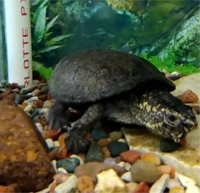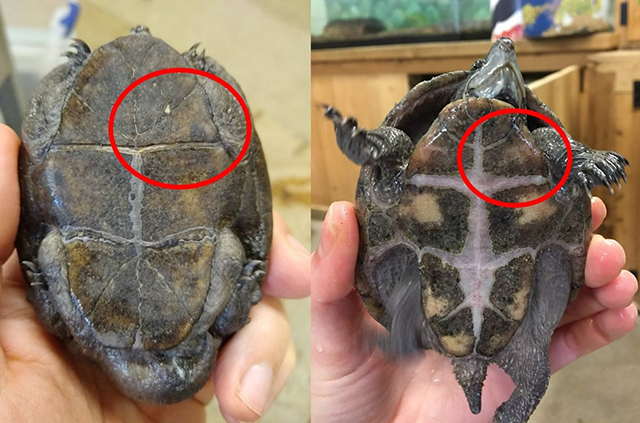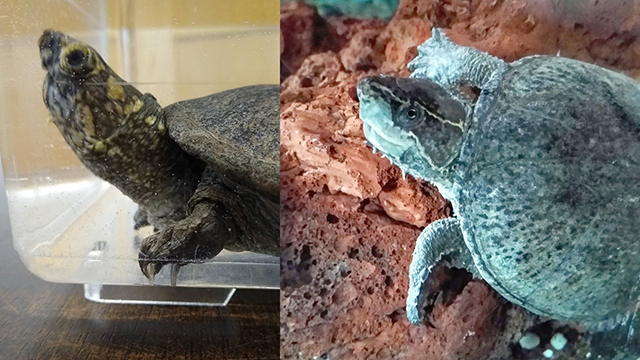In this video, I identified Marty as a musk turtle and shared some natural history information about musk turtles, which are native to most of the Eastern United States, including the Milwaukee area. Musk turtles are small, dark in color, and mostly non-descript. Shortly after posting the video, one of my college professors from my time as a biology student at St. Olaf (Um Ya Ya!) reached out to me. Steve Freedberg has studied North American turtles for years, so when he suggested that I may have misidentified Marty, I knew this was the real deal.
There’s another species of North American turtle called the mud turtle. Mud turtles are small, dark in color, and mostly non-descript. Sound familiar? Differentiating musk turtles from mud turtles is not an easy task, as their most distinctive difference comes down to the shape of the scales on the underside of their shells. The specific scales we are looking at are called pectoral scutes – pectoral referring to the “chest” region (or the equivalent space on the turtle’s body) and scute being a word for the scales on a turtle’s shell.
Here are two images that compare Marty’s pectoral scutes (on the left) to those of Bobber, our resident musk turtle at the Washington Park branch (on the right). In a mud turtle, the pectoral scutes are triangular; in a musk turtle, they are rectangular. Marty’s are triangular and Bobber’s are not! This was the diagnostic feature, the trait that confirmed that we had, indeed, been calling Marty by the wrong species. Many apologies to Marty!
Marty, on the left, has a triangular pectoral scute while Bobber, on the right, has a more rectangular shaped pectoral scute
There are a handful of other features that distinguish musk from mud turtles. One such feature is that more skin is visible between the scutes of a musk turtle than a mud turtle (the difference between Marty and Bobber is clearly visible in the images above). Additionally, Eastern musk turtles have two white stripes on the side of their heads. Mud turtles may have a faint white stripe, but not nearly as distinctive as the musk turtles, which we can again see on Marty and Bobber in these images.
Marty, on the left, has no stripe on the side of his head while Bobber, on the right, has two distinctive stripes
Another trait of musk turtles that always had me curious is the fact that, when threatened, they give off a musky odor as a defense mechanism. This is, in fact, how they got their name of MUSK turtle and their colloquial name of "Stinkpot." And I noticed that Marty never gave off that distinctive smell. I chalked this up to him being a turtle in captivity, comfortable in our care, but the real reason seems to be the absence of those stinky glands in the first place!
Identifying Marty’s true species raised another question, though. Because as it turns out, Eastern mud turtles are not native to Wisconsin; the closest you would find one is southeastern Illinois. So, if not from around Milwaukee, where did Marty even come from?
Tracking down Marty’s origin turned into a bit of a forensic investigation. Menomonee Valley branch manager Glenna Holstein recalled that Marty had been living in the Washington Park animal room prior to the opening of the MV branch. So we reached out to long-time staff members from the Washington Park branch to see what they recalled. We followed the thread and eventually discovered that Marty was originally recovered by the DNR from an individual who was illegally keeping reptiles in their home. So Marty was probably captured from somewhere in his home range and brought to this individual’s home before he was recovered and relocated to the Urban Ecology Center to live out the rest of his life in our care.
It was disconcerting to learn that something that I had assumed was correct and confidently shared with the world turned out to be an error. Especially as we are an organization that prides itself on educating the public about the natural world, an organization that you all trust to share accurate information with you. However, part of education, part of learning, is recognizing that we don’t always know everything. There are always new things to learn. There are always mistakes to be made. And once I swallowed my pride, I was able to recognize that this mistake we were making is representative of the pretty cool reality that we are always learning new things about the natural world around us.
At the Urban Ecology Center, we will continue learning and growing and sharing in the wonder of discovery with you. And Marty will be our reminder that we always have more to learn.







